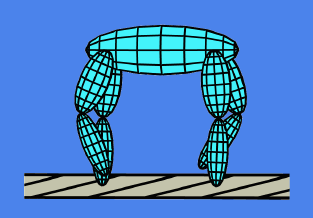Optimal Dynamically Stable Quadruped Walking for Different Gaits



Summary
The problem of finding optimal, dynamically stable gaits for a quadruped
robot is considered.
Trajectories are sought which minimize the actuation energy required
for walking in an attempt to approximate natural motion.
The number of possible gaits for a quadruped is quite large
when one considers varied orders of leg motion,
different liftoff times, and various ground contact
combinations for the legs.
The problem is treated as a fully nonlinear
optimal hybrid path planning problem on a 22-dimensional state space.
The model of the multi-body dynamics
describing the motion in the sagittal plane consists
of 9 rigid bodies.
The resulting nonlinear dynamical systems
consists of 22 independent, continuous state variables
(i.e. 22 first order ordinary differential equations)
and 8 continuous control variables.
The objective of the nonlinear, hybrid optimal control problem
for optimal walking at different gaits
is to minimize the total energy required per step length.
Computational results are presented using
a recursive, articulated body algorithm for the formulation
of the legged robot dynamics and
a direct collocation and
sparse nonlinear programming SQP method
for the solution of the nonlinear, hybrid optimal control problem.
Video
 AVI file (17.8 MB)
AVI file (17.8 MB)
Relevant Publications
-
M. Hardt, O. von Stryk:
The role of motion dynamics in the design, control and stability
of bipedal and quadrupedal robots.
Accepted as full paper for
RoboCup
2002 International Symposium,
June 24-25, 2002, Fukuoka, Japan.
-
M. Hardt, O. von Stryk:
Increasing stability in dynamic gaits using numerical
optimization.
Proc. 15th IFAC World
Congress, Barcelona, Spain, July 21-26, 2002.
-
M. Hardt, O. von Stryk:
Towards optimal hybrid control solutions for gait patterns of a
quadruped.
In: M. Armada, P. Gonzalez de Santos (eds.):
Proc. CLAWAR 2000 - 3rd International Conference on Climbing and Walking Robots,
Madrid, October 2-4, 2000 (Bury St. Edmunds and London, UK: Professional
Engineering Publishing, 2000) pp. 385-392.
PostScript file
(269kb),
PDF
file (89kb).
 Fachgebiet Simulation und Systemoptimierung, TU Darmstadt
Fachgebiet Simulation und Systemoptimierung, TU Darmstadt



 AVI file (17.8 MB)
AVI file (17.8 MB)
 Fachgebiet Simulation und Systemoptimierung, TU Darmstadt
Fachgebiet Simulation und Systemoptimierung, TU Darmstadt
![]()